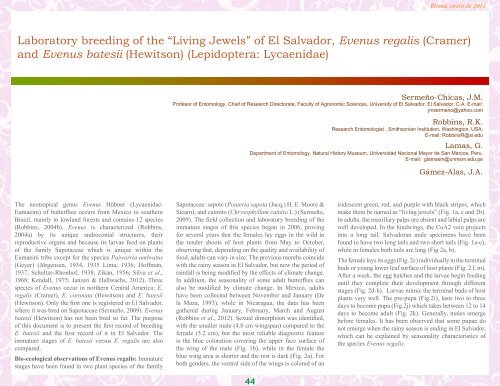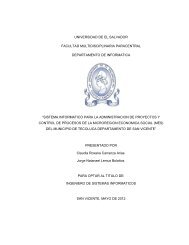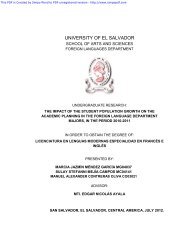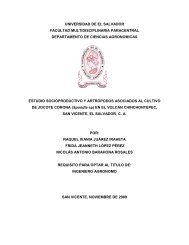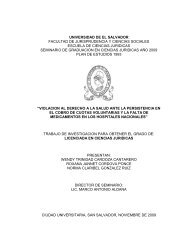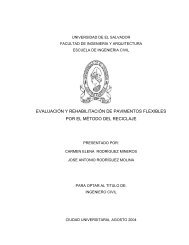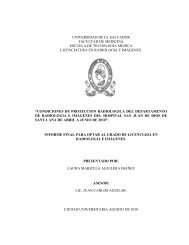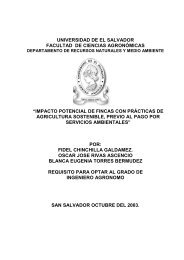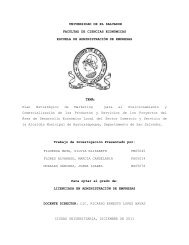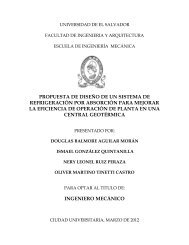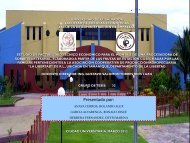Bioma, enero de 2013 - Smithsonian, National Museum of Natural ...
Bioma, enero de 2013 - Smithsonian, National Museum of Natural ...
Bioma, enero de 2013 - Smithsonian, National Museum of Natural ...
You also want an ePaper? Increase the reach of your titles
YUMPU automatically turns print PDFs into web optimized ePapers that Google loves.
44<br />
<strong>Bioma</strong>, <strong>enero</strong> <strong>de</strong> <strong>2013</strong><br />
Laboratory breeding <strong>of</strong> the “Living Jewels” <strong>of</strong> El Salvador, Evenus regalis (Cramer)<br />
and Evenus batesii (Hewitson) (Lepidoptera: Lycaenidae)<br />
Sermeño-Chicas, J.M.<br />
Pr<strong>of</strong>esor <strong>of</strong> Entomology, Chief <strong>of</strong> Research Directorate, Faculty <strong>of</strong> Agronomic Sciences, University <strong>of</strong> El Salvador. El Salvador, C.A. E-mail:<br />
jmsermeno@yahoo.com<br />
Robbins, R.K.<br />
Research Entomologist , <strong>Smithsonian</strong> Institution, Washington, USA.<br />
E-mail: RobbinsR@si.edu<br />
Lamas, G.<br />
Department <strong>of</strong> Entomology, <strong>Natural</strong> History <strong>Museum</strong>, Universidad Nacional Mayor <strong>de</strong> San Marcos. Peru.<br />
E-mail: glamasm@unmsm.edu.pe<br />
Gámez-Alas, J.A.<br />
The neotropical genus Evenus Hübner (Lycaenidae:<br />
Eumaeini) <strong>of</strong> butterflies occurs from Mexico to southern<br />
Brazil, mainly in lowland forests and contains 12 species<br />
(Robbins, 2004b). Evenus is characterized (Robbins,<br />
2004a) by its unique androconial structures, their<br />
reproductive organs and because its larvae feed on plants<br />
<strong>of</strong> the family Sapotaceae which is unique within the<br />
Eumaeini tribe except for the species Paiwarria umbratus<br />
(Geyer) (Jörgensen, 1934, 1935 Lima, 1936; H<strong>of</strong>fman,<br />
1937; Schultze-Rhonh<strong>of</strong>, 1938; Zikán, 1956; Silva et al.,<br />
1968; Kendall, 1975; Janzen & Hallwachs, 2012). Three<br />
species <strong>of</strong> Evenus occur in northern Central America: E.<br />
regalis (Cramer), E. coronata (Hewitson) and E. batesii<br />
(Hewitson). Only the first one is registered in El Salvador,<br />
where it was bred on Sapotaceae (Sermeño, 2009). Evenus<br />
batesii (Hewitson) has not been bred so far. The purpose<br />
<strong>of</strong> this document is to present the first record <strong>of</strong> breeding<br />
E. batesii and the first record <strong>of</strong> it in El Salvador. The<br />
immature stages <strong>of</strong> E. batesii versus E. regalis are also<br />
compared.<br />
Bio-ecological observations <strong>of</strong> Evenus regalis: Immature<br />
stages have been found in two plant species <strong>of</strong> the family<br />
Sapotaceae: sapote (Pouteria sapota (Jacq.) H. E. Moore &<br />
Stearn), and caimito (Chrysophyllum cainito L.) (Sermeño,<br />
2009). The field collection and laboratory breeding <strong>of</strong> the<br />
immature stages <strong>of</strong> this species began in 2006, proving<br />
for several years that the females lay eggs in the wild in<br />
the ten<strong>de</strong>r shoots <strong>of</strong> host plants from May to October,<br />
observing that, <strong>de</strong>pending on the quality and availability <strong>of</strong><br />
food, adults can vary in size. The previous months coinci<strong>de</strong><br />
with the rainy season in El Salvador, but now the period <strong>of</strong><br />
rainfall is being modified by the effects <strong>of</strong> climate change.<br />
In addition, the seasonality <strong>of</strong> some adult butterflies can<br />
also be modified by climate change. In Mexico, adults<br />
have been collected between November and January (De<br />
la Maza, 1993), while in Nicaragua, the data has been<br />
gathered during January, February, March and August<br />
(Robbins et al., 2012). Sexual dimorphism was i<strong>de</strong>ntified,<br />
with the smaller male (4.8 cm wingspan) compared to the<br />
female (5.2 cm), but the most reliable diagnostic feature<br />
is the blue coloration covering the upper face surface <strong>of</strong><br />
the wing <strong>of</strong> the male (Fig. 1b), while in the female the<br />
blue wing area is shorter and the rest is dark (Fig. 2a). For<br />
both gen<strong>de</strong>rs, the ventral si<strong>de</strong> <strong>of</strong> the wings is colored <strong>of</strong> an<br />
iri<strong>de</strong>scent green, red, and purple with black stripes, which<br />
make them be named as “living jewels” (Fig. 1a, c and 2b).<br />
In adults, the maxillary palps are absent and labial palps are<br />
well <strong>de</strong>veloped. In the hindwings, the CuA2 vein projects<br />
into a long tail. Salvadoran male specimens have been<br />
found to have two long tails and two short tails (Fig. 1a-c),<br />
while in females both tails are long (Fig 2a, b).<br />
The female lays its eggs (Fig. 2c) individually in the terminal<br />
buds or young lower leaf surface <strong>of</strong> host plants (Fig. 2 l, m).<br />
After a week, the egg hatches and the larvae begin feeding<br />
until they complete their <strong>de</strong>velopment through different<br />
stages (Fig. 2d-h). Larvae mimic the terminal buds <strong>of</strong> host<br />
plants very well. The pre-pupa (Fig.2i), lasts two to three<br />
days to become pupa (Fig.2j) which takes between 12 to 14<br />
days to become adult (Fig. 2k). Generally, males emerge<br />
before females. It has been observed that some pupae do<br />
not emerge when the rainy season is ending in El Salvador,<br />
which can be explained by seasonality characteristics <strong>of</strong><br />
the species Evenus regalis.


